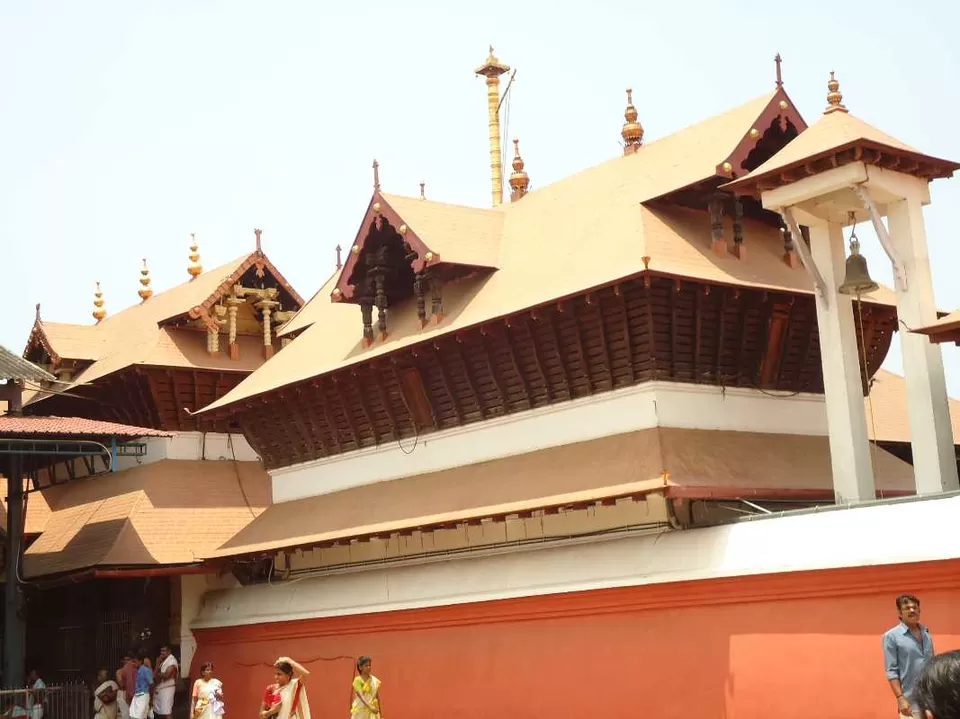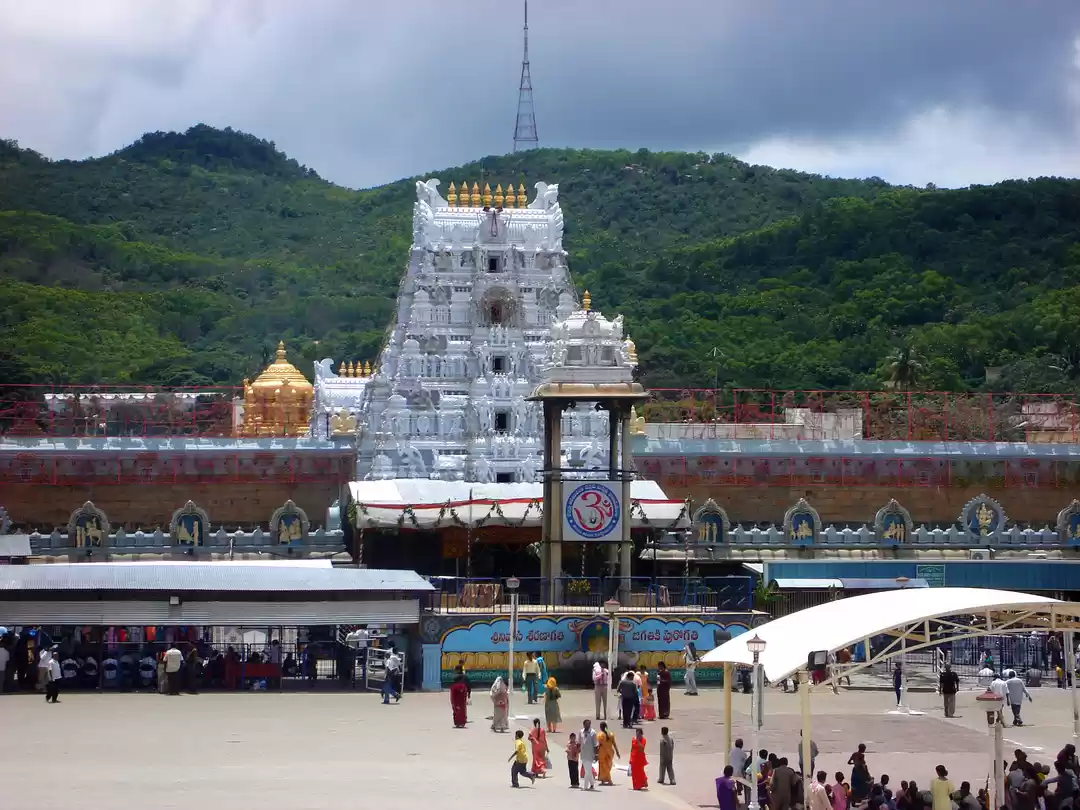Guruvayur Temple in Kerala is one of the most sacred and revered temples in India, dedicated to Lord Krishna, an avatar of Lord Vishnu. Located in the town of Guruvayur, about 29 km from Thrissur, the temple is also known as Guruvayoorappan or Unnikrishnan, meaning the child form of Krishna.
The temple's origins are shrouded in legend, believed to date back over 5,000 years and is believed to be one of the 108 most divine Vishnu temples in the world and attracts millions of devotees every year. The temple's elephant sanctuary, Punnathur Kotta, is a must-visit attraction where visitors can witness these majestic animals up close.
History of Guruvayur Temple

- The idol of Lord Krishna worshipped in the temple is said to be made by Lord Vishwakarma from a rare material called Padala Anjanam.
- The idol was originally installed by Lord Brahma in Dwaraka, the kingdom of Lord Krishna.
- After the death of Krishna and the destruction of Dwaraka by the sea, the idol was retrieved by Guru and Vayu and brought to Kerala.
- They found a suitable place near a lotus pond where Lord Shiva and Parvati were meditating, and Shiva welcomed them, offering the place for installing the idol.
- Shiva named the place Guruvayur, meaning the place of Guru and Vayu, establishing the temple as a holy abode of Lord Krishna.
- It was renovated and restored by many kings and rulers, such as the Cheras, the Zamorins, the Dutch, Tipu Sultan, and the British.
- It was also attacked and plundered by invaders and robbers, such as the Mysore Muslim army in 1766 and Hyder Ali’s army in 1789.
- The temple played a significant role in the social and cultural movements of Kerala, including the Guruvayur Satyagraha in 1931-32, which demanded entry for lower caste Hindus into the temple.
- The temple was also visited by many eminent personalities, such as Mahatma Gandhi, Rabindranath Tagore, Chembai Vaidyanatha Bhagavatar, and M.S. Subbulakshmi.
Architecture of Guruvayur Temple

Architecture Overview:
- Reflects typical Kerala temple construction style based on Vastu Shastra.
- East-facing with two gopurams (towers) at eastern and western entrances.
Gopurams:
- Eastern gopuram (Kizhakkenada): Seven storeys with intricate carvings depicting Hindu mythology scenes.
- Western gopuram (Paringjarenada): Five storeys with similar decorations.
Main Structures:
- Sreekovil (Sanctum Sanctorum): Houses standing idol of Lord Krishna with four arms, adorned with tulsi garland and gold ornaments.
- Nalambalam (Outer Enclosure): Surrounds Sreekovil, has pillared corridors with murals of Krishna’s life, and features Dhwajasthambham (33.5m high flag mast) and Deepasthambham (7m high pillar-of-lamp).
- Chuttambalam (Outer Pavilion): Circular structure enclosing Nalambalam, with tiled roof supported by wooden pillars with deity carvings, and an oottupura (dining hall) for serving free meals to devotees.
- Anakottil (Elephant Yard): Spacious area for temple elephants, more than 50 of which are owned by the temple, including the famous Guruvayur Kesavan, whose statue is erected in front of the Sreekovil.
Timings and Rituals of Guruvayur Temple

The temple follows a strict schedule of poojas and rituals throughout the day, opening at 3.00 AM and closing at 9.15 PM, with a break from 1.30 PM to 4.30 PM. The main poojas include:
- Nirmalyam: The first pooja of the day, involving bathing and cleaning the idol with holy water.
- Usha Pooja: The morning pooja, where the idol is decorated with flowers and offered various delicacies.
- Ucha Pooja: The noon pooja, offering rice and other dishes to the idol.
- Athazha Pooja: The evening pooja, where fruits and sweets are offered to the idol.
- Thrippuka: The last pooja of the day, anointing the idol with sandal paste and camphor.
Must read: 7 Temple Festivals in Kerala You Cannot Miss
Rituals & Festivals At Guruvayur Temple

Other rituals at Guruvayur Temple include
Abhishekam: Anointing the idol with sacred substances like milk, honey, and ghee.
Alankaram: Decorating the idol with flowers, jewelry, and silk clothes.
Seeveli: Procession of the deity around the temple premises on elephant back.
Deeparadhana: Offering of lamps to the deity.
Nivedyam: Offering of food to the deity.
Guruvayur Temple in Kerala celebrates several festivals throughout the year, attracting devotees from far and wide. Some of the major festivals celebrated at the temple include:
Guruvayur Ekadasi: This is a grand festival celebrated in the Malayalam month of Vrischikam (November-December) and is dedicated to Lord Krishna. The festival spans 10 days and includes various rituals and cultural programs.
Vishu: Celebrated in the Malayalam month of Medam (April-May), Vishu marks the Malayalam New Year. The festival is celebrated with traditional rituals and feasting.
Ashtami Rohini: Celebrated in the Malayalam month of Chingam (August-September), Ashtami Rohini marks the birthday of Lord Krishna. The festival is celebrated with special prayers and offerings.
Chembai Music Festival: This annual music festival is held in Guruvayur in memory of the renowned Carnatic musician Chembai Vaidyanatha Bhagavatar. The festival attracts eminent musicians and music enthusiasts from across the country.
Guruvayur Utsavam: This is the annual festival of the Guruvayur Temple and is celebrated with great pomp and splendor. The festival includes processions, cultural programs, and other festivities.
Must Read: Top 11 famous temples in India everyone should visit
Best Time To Visit Guruvayur Temple

The best time to visit Guruvayur Temple is early in the morning or late in the evening to avoid the crowds. Weekdays are generally less crowded than weekends and festivals. It's also advisable to check the temple's website or contact them directly for information on special events or festivals that may attract larger crowds.
You may also like to read: Explore Kerala for a lifetime unforgettable memory
Nearby Attractions to Guruvayur Temple

The temple is not only a spiritual destination but also a cultural and natural one. There are many attractions near the temple that devotees can visit and enjoy.
Punnathurkotta Elephant Palace: A sanctuary for over 50 elephants that belong to the temple. The elephants are trained and groomed by mahouts and participate in various rituals and festivals at the temple. It also has a museum that displays the history and artifacts related to the elephants. The palace is about 3 km from the temple and can be reached by auto or taxi.
Gokulam and Vrindavanam Estate: Known for its picturesque tea plantations, Gokulam Estate offers stunning views of rolling hills covered with lush green tea bushes. Vrindavanam Estate is a paradise for its spice gardens and organic farming practices. Visitors can explore the aromatic spice plantations, including pepper, cardamom, cinnamon, and more, and witness sustainable farming methods in action.
Mammiyoor Shiva Temple: This temple is dedicated to Lord Shiva, who is considered as the father-in-law of Lord Krishna. The temple is believed to be as old as Guruvayur Temple and has a beautiful idol of Shiva in a dancing posture. The temple is also famous for its mural paintings and sculptures.
Chavakkad Beach: A scenic beach with golden sand and coconut trees. The beach is ideal for relaxing, swimming, sunbathing and watching the sunset. The beach also has a fishing harbor where fishermen bring in their catch and sell it on the shore. The beach is about 5 km from Guruvayur Temple.
Institute of Mural Painting: This center is for learning and preserving the art of mural painting, which is a traditional form of painting on walls using natural colors and materials. The institute offers courses and workshops for students and enthusiasts who want to learn this art form. The institute also has a gallery that displays some of the finest mural paintings in Kerala.
Accommodations Near Guruvayur Temple

Krishna Inn: Located near the temple, Krishna Inn offers comfortable rooms with modern amenities. The hotel also has a restaurant serving vegetarian cuisine.
Distance from Temple: Approximately 300 meters.
Mayura Residency: Situated close to the temple, Mayura Residency provides spacious rooms with facilities like AC, TV, and attached bathrooms. The hotel also has a multi-cuisine restaurant.
Distance from Temple: Approximately 500 meters.
Sree Gokulam Sabari: This hotel offers budget-friendly accommodation with clean rooms and basic amenities. It is located within walking distance from the temple.
Distance from Temple: Within walking distance.
Guruvayur Gateway: A luxury hotel near the temple offering well-appointed rooms, a swimming pool, and a restaurant serving delicious meals.
Distance from Temple: Approximately 700 meters.
Bhasuri Inn: This hotel provides comfortable rooms with modern amenities and is located near the temple. It also has a restaurant serving vegetarian and non-vegetarian dishes.
Distance from Temple: Approximately 400 meters.
Customize your Kerala trip with Tripoto
Dress Code for Visiting Guruvayur Temple

- Only Hindus are allowed inside the temple.
- Men: Dhoti or mundu (white cloth wrapped around waist) without shirt or vest.
- Women: Saree or salwar kameez with dupatta covering head.
- Children: Traditional attire; no jeans, trousers, shorts, skirts, t-shirts, etc.
How to Reach Guruvayur Temple

By Air: The nearest airport is Cochin International Airport (87 km away), with flights to major domestic and international destinations. From the airport, one can take a taxi or bus to reach the temple.
By Rail: The nearest railway station is Guruvayur Railway Station (500 meters away), with trains to cities like Chennai, Bangalore, and Trivandrum. Alternatively, Thrissur Railway Station (29 km away) is a major station with trains to cities across India. From both stations, one can take a taxi or bus to reach the temple.
By Road: Guruvayur is well-connected by road with cities and towns in Kerala, Tamil Nadu, and Karnataka. Kerala State Transport Corporation (KSRTC) buses operate from cities across Kerala, Tamil Nadu, and Karnataka. Private buses and taxis are also available for travel to the temple.
Tips for Visiting Guruvayur Temple

- Cloak room, locker room, shoe stand are available for devotees at nominal fee or free of cost.
- Temple is usually crowded, especially during festivals and weekends.
- Long queues for darshan and offerings; visit early morning or late evening to avoid rush.
- Book online in advance to save time.
- Respect sanctity and serenity of temple; no noise, photos, videos, littering.































